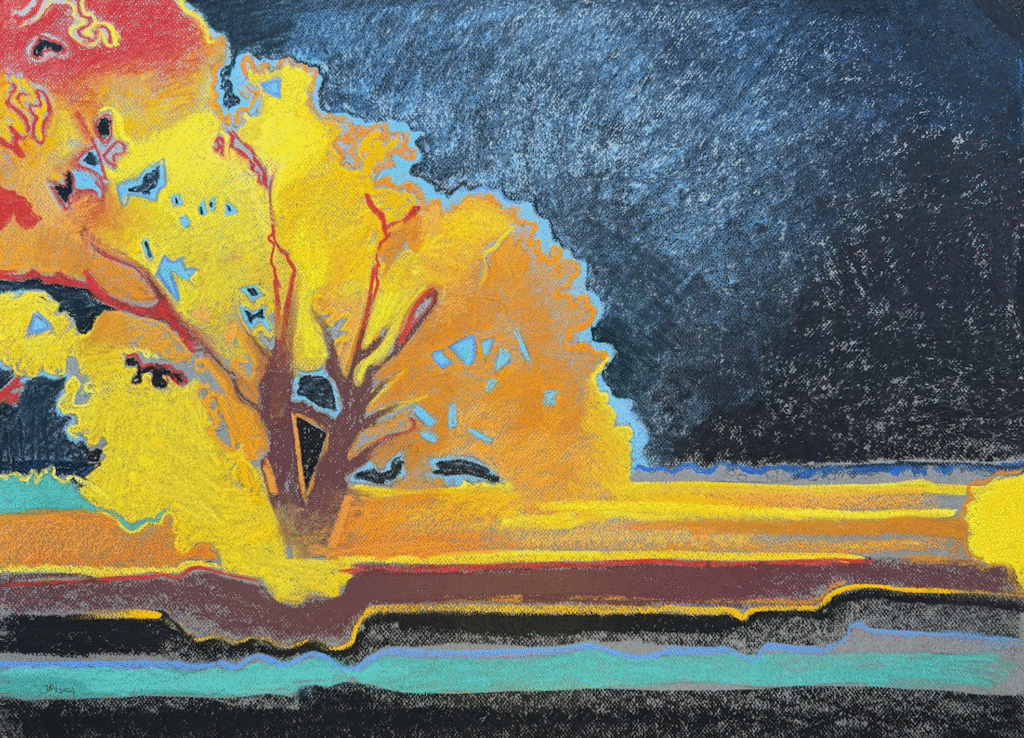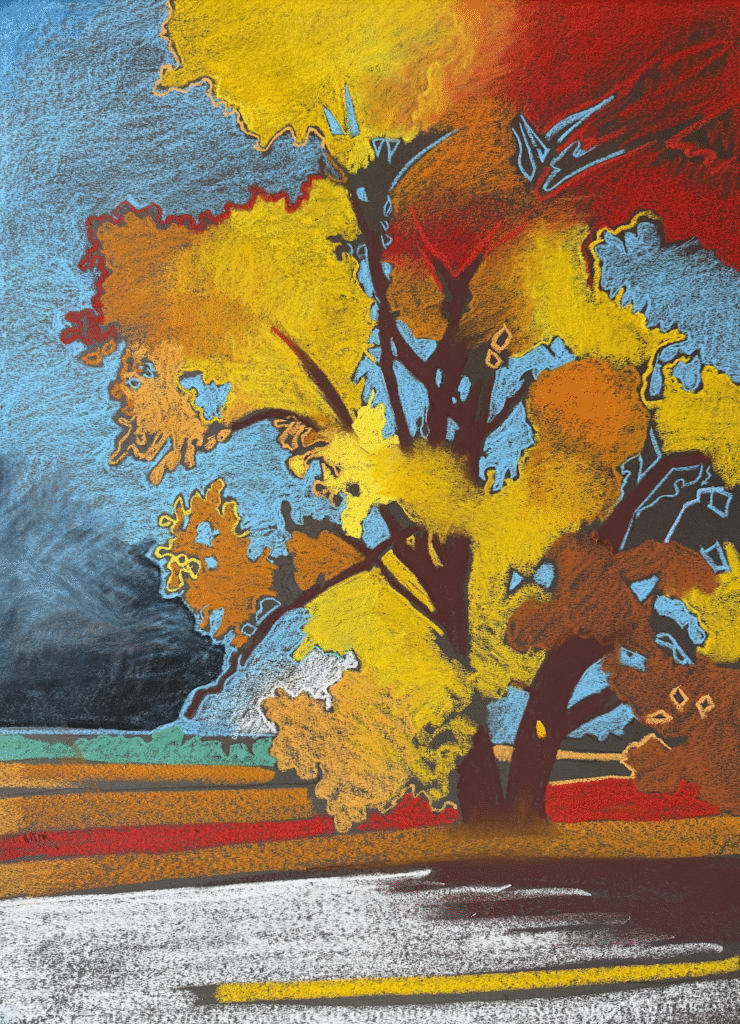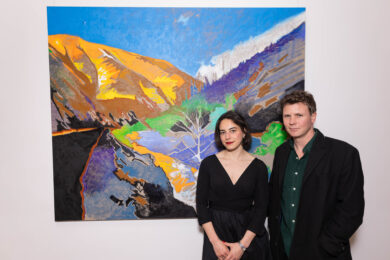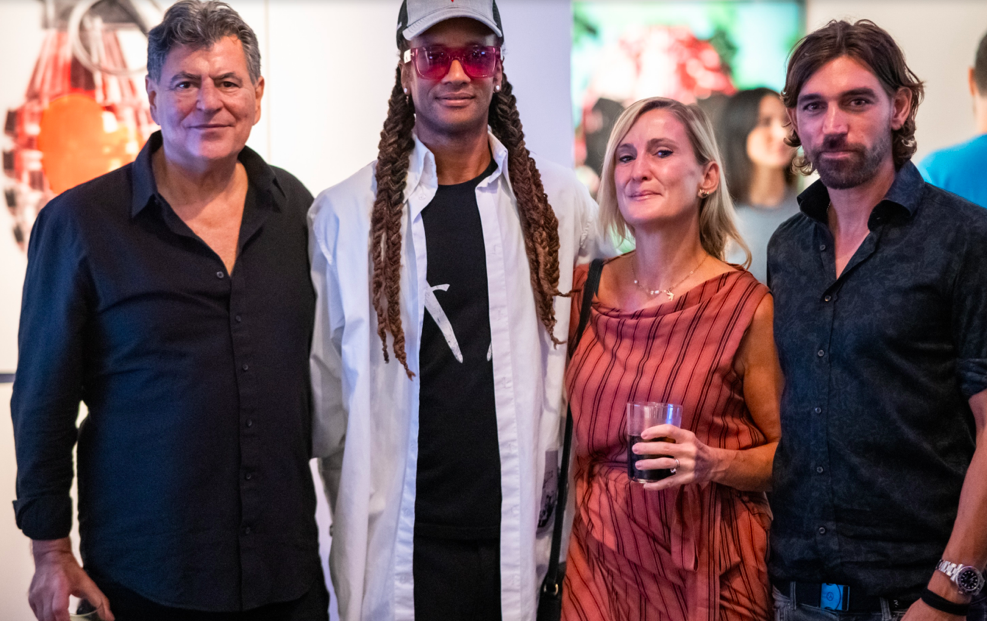Culturalee spoke to Kenyan-born artist James Vaulkhard and curator MC Llamas about The Sublime & The Consumed, Vaulkhard’s solo exhibition at Blond Contemporary in London. The exhibition is curated by MC Llamas, Director of GUERIN PROJECTS.
The Sublime & The Consumed features a new series of paintings and pastel drawings inspired by an epic journey undertaken by Vaulkhard in 2024– inspired by the Hudson River School painters–when he travelled 5,000 miles across the US and into the American sublime. During the journey, Vaulkhard witnessed a nation at a key moment in its history, faced with environmental reckoning and political uncertainty.

Culturalee: Where did the title ’The Sublime & The Consumed’ come from?
James Vaulkhard: The title, “The Sublime & The Consumed,” really came as an afterthought towards the end of my travels across America. What stood out to me, again and again, was just how vast and powerful these landscapes are. There’s this sense of awe- which is was expecting, something spiritual, that those painters were so fixated on capturing. But at the same time, I couldn’t ignore all the ways these landscapes have been changed and, in some cases, consumed by people—through settling, industry, tourism, and all the marks of modern life. Even the most beautiful places aren’t untouched; you can feel the layers of history and human impact everywhere.
So, the title really reflects that tension: the breathtaking power of nature set against the reality of how it’s been shaped, used, and sometimes devoured by us. In the end, it’s both a tribute to the tradition of American landscape painting and a way of looking honestly at what’s changed, what’s been lost, or even commodified along the way.
You have collaborated with MC Llamas on several projects including a successful exhibition at the British Art Fair at Saatchi Gallery last year and now the solo show at Blond Contemporary. Does it make a huge difference for an artist to have a good understanding with their curator?
Oh yes, it makes a huge difference. Most of the time it’s a solitary routine. You’re in the studio, head full of half-formed ideas, sometimes getting stuck in your own loop. It can get a bit lonely—or at least, you start doubting what you’re making, because there’s no one to bounce it off.
So working with a curator is very important for me. My relationship with MC is unusual I think—it’s always been more of a friendship that just naturally turned into a business relationship over time. We met in Florence then, exhibited in a group show in 2014 back in London and as she started to lean more into curating we started working together on a few group exhibitions and more recently a couple of solo exhibitions.
She’s not just picking paintings for a wall; it’s more like having a running conversation, a proper dialogue. Sometimes she’ll spot something in my work that I never even noticed, or she’ll challenge me to push something further. Other times, it’s just talking through the messier bits—what’s not working, or where things feel stuck. Those conversations kind of pull you out of your own bubble and get you looking at your work from a new angle.

At the British Art Fair you exhibited a series of paintings and drawings of Kenya, where you spent much of your childhood, a place which is therefore close to your heart. What drew you to America–a country that is more anonymous to you than Kenya–to undertake such an epic 5,000 mile journey for the exhibition at Blond contemporary?
Kenya’s always felt like home—full of memories and meaning for me. Painting it is almost second nature. But America was different. I didn’t really know it at all; it felt anonymous and huge. That’s what drew me to it. I wanted to step out of my comfort zone, to experience a landscape without all the personal history attached.
Traveling across America was a way to look at things with fresh eyes, to really see rather than just remember. There’s a kind of excitement in being a stranger in a place—you notice different things; you ask more questions. It was sometimes lonely, sure, but it pushed me to make new discoveries in my work. That sense of not-knowing was inspiring. I think the journey gave the paintings their own energy—rooted in curiosity, not nostalgia.
You have been inspired by the Hudson River School painters for this American Odyssey series of paintings, and there is also still evidence of your classical training in Italy. Who would you say are your biggest artistic influences?
Yes, the Hudson River School painters were a big influence for this series—painters like Thomas Cole and Frederic Church. The way they captured the vastness and drama of the landscape really stuck with me. There’s something almost cinematic about it. But I can’t ignore my classical training in Italy, either. Those years in Florence, learning from artists who cared about light, structure, and the old techniques, that’s still in my practice—people like Caravaggio, but also the teachers I worked with in the studios there.
Beyond that, I’ve always been drawn to artists who really see the world differently—like Joseph Albers with his colour work, or even more modern painters who push the boundaries, like Peter Doig. I guess my influences are a mix: the old masters, the American landscape painters, and then some contemporary artists who play with perception and feeling. It’s a bit of a jumble, but somehow it all filters into the way I look at a scene and then attempt to describe it.
Culturalee: You have been something of a mentor to James, encouraging him on his artistic journey and nurturing his increasing use of colour with your presentation at British Art Fair in 2024, and now the solo show at Blond Contemporary. Can you describe the Curator-Artist relationship between you, and how your curatorial skills complement James’s vision and push it forward?
MC Llamas: I have always had a deep admiration and respect for James and his work. We met in Florence about 10 years ago and our relationship developed slowly from there. He is so committed to his practice. We have a lot of conversations about his work, I do a lot of studio visits. I instinctively see moments in the paintings which we have conversations about. I ask him where narratives come from, the stories behind the pieces and I think it helps unlock his process. It’s easy for an artist to get into the cycle of painting and the loneliness attached to it, I’m here to reinforce their confidence in the work that they’re making and remind them of what they have gone through to get to a specific point. I’m very involved with the artists I work with, I’ve often known them for years, so I have great visibility of their stories and developments. Artists send me process images daily, seeking reassurance or advice, which I love to help with. I track the process and notice the details that matter.
James’s new paintings are rooted in nature and depict in glorious technicolour the landscape of America. Is this vision an intentional focus on the natural beauty of America as an antidote to the political turmoil there at the moment?
I’m not sure that James’ works reflect on a political story. He travelled across the states at an interesting moment in their politics, but I believe that it was serendipity more than anything!
How would you describe James’s style and would you say he is a talent to watch and start collecting now?
James has been producing very strong work very consistently, his paintings echo the aesthetic of Peter Doig and David Hockney and he sits within the contemporary art sphere very solidly. His pieces are incredibly generous in their storytelling, it is a joy to live with them!
James Vaulkhard: The Sublime & The Consumed is at Blond Contemporary until 9th May, 2025.




